Hops in Beer Brewing: Dana
Published: October 13, 2025 at 5:30:30 PM UTC
Dana hops originate from Slovenia and are celebrated for their dual-purpose nature. They are favored by brewers for their balanced bittering and aromatic qualities. Developed at the Institute of Hop Research in Žalec, Dana hops combine floral, citrus, and pine notes. They also offer reliable alpha acids for bittering.
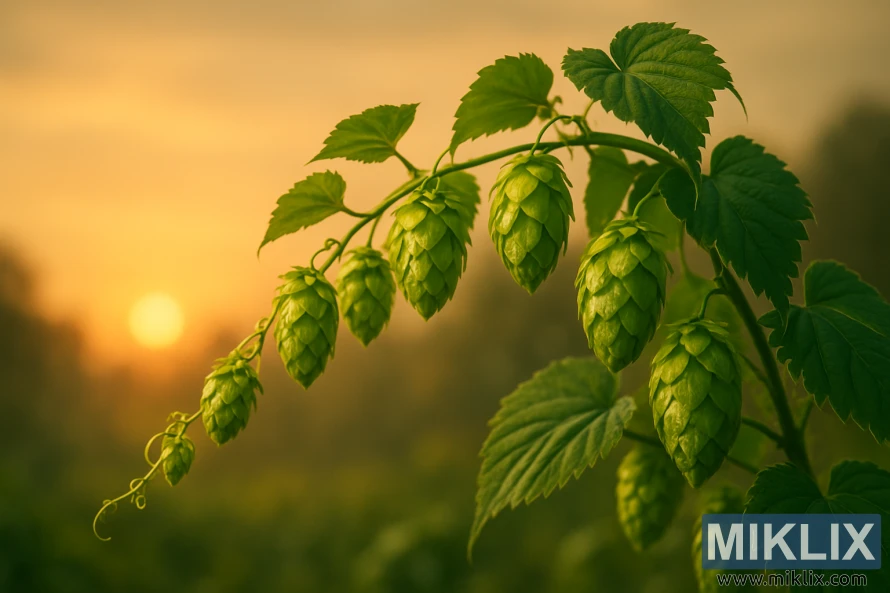
Dana hops are frequently found in both hobbyist and commercial recipe databases. They are highly valued for their versatility in all hop additions. Brewers appreciate their use in both early kettle additions and late aroma work. Growers in Slovenia also highlight their consistent yields and strong market demand.
This introduction sets the stage for the article's exploration of Dana hops. It will cover their origin, chemical profile, flavor and aroma, brewing applications, agronomy, substitutions, recipe examples, and U.S. sourcing and labeling considerations.
Key Takeaways
- Dana hops are a Slovenian dual-purpose hop well suited to bittering and aroma work.
- The Dana hop variety was bred in Žalec from Hallertauer Magnum and a local wild male.
- Expect floral, citrus, and pine character useful across many beer styles.
- Widely used in recipe databases and pairs well with varieties like Cascade and Saaz.
- The article will cover chemistry, brewing applications, agronomy, and sourcing for U.S. brewers.
Origin and Breeding of Dana Hops
Dana hops originate from Slovenia, where a focused breeding program aimed to create a versatile cultivar. The Žalec Institute, renowned for its expertise, combined imported and native genetics to fulfill contemporary brewing demands. This effort resulted in Dana, a cultivar that stands out in the world of hops.
The breeding process of Dana involved a strategic cross between Hallertauer Magnum and local Slovenian germplasm. This combination aimed to enhance both agronomic performance and flavor potential. The records highlight the use of a wild Slovenian male to strengthen these aspects.
The Žalec Institute played a pivotal role in the selection and testing phases of Dana's development. The focus was on achieving yield stability, disease resistance, and a dual-purpose use. This dual-purpose nature allows Dana to contribute both to the bittering and aroma aspects of beer.
The Slovenian hop breeding programs significantly contributed to Dana's regional diversity and resilience. This local input ensured that Dana retains its bold bittering qualities while offering pleasant aroma notes. These characteristics are highly valued by craft brewers worldwide.
- Lineage: Hallertauer Magnum cross with native Slovenian hop genetics.
- Developer: Institute of Hop Research in Žalec, Slovenia.
- Use: Dual-purpose cultivar with strong agronomic traits.
Dana hops: Key Chemical and Oil Composition
Dana hops exhibit a dual-purpose profile. The alpha acid content varies, with figures ranging from 7.2–13%, 6.4–15.6%, and 9–13%. Beermaverick reports an average of 10.1%.
Beta acids also show variability. They range from 2.7–6% with an average of 4.4%. Some reports suggest values near 2.0% and a 4–6% range. These figures are crucial for understanding aging and oxidation in beer.
Cohumulone is a significant component of the alpha acids. It ranges from 22–31% and 28–31%, with averages around 26.5%. This cohumulone level affects the perceived bitterness and bite.
The hop oil profile of Dana is complex. Beermaverick reports total oils at 0.9–1.6 mL/100 g, averaging 1.3 mL. Another source indicates a range of 20.4–30.9 mL/100 g, possibly due to a different scale. Both figures are provided for clarity.
Beermaverick's oil breakdown highlights myrcene's dominance, with 35–53% (44% average). Humulene follows at 20–27% (23.5% average). Caryophyllene and farnesene are present at roughly 4–8% and 6–9% respectively.
Alternate oil data shows some variation. Another source lists myrcene at 50–59%, humulene at 15–21%, and farnesene at 6–9%. These differences are due to factors like growing conditions, harvest timing, and analysis methods.
- Myrcene drives resinous, citrus, and fruity notes and makes up a large share of the hop oil profile.
- Humulene contributes woody, herbal, and lightly noble tones.
- Cohumulone proportion influences bitterness character and can heighten astringency when used aggressively.
Understanding these values reveals Dana as a moderately high-alpha hop with substantial aromatic oil content. The balance of myrcene and humulene supports both bittering and flavor/aroma use. Cohumulone levels suggest a measured, sometimes sharper bitterness within the alpha acids Dana range.
Flavor and Aroma Profile
Dana's flavor profile is a blend of lemon-like citrus, delicate florals, and a clear pine resin character. Brewers find its scent moderately intense, reading as bright and fresh. The citrus notes lead, while floral undertones round out the middle.
Hop sensory notes reveal Dana's myrcene-driven citrus and resinous top notes. Humulene and farnesene contribute woody and lightly noble floral accents. This combination creates a layered aroma suitable for late-boil, whirlpool, and dry-hop applications.
Tasters find Dana's aroma pleasant and direct, with an intensity of about 7 on a 10-point scale. Its bitterness is medium to slightly robust. This balance makes it ideal for pale ales and lagers.
Dana is celebrated for its versatility. It pairs well with both delicate malt bills and robust hop blends. Its citrus floral pine character enhances a beer's aroma without overwhelming the base flavors.
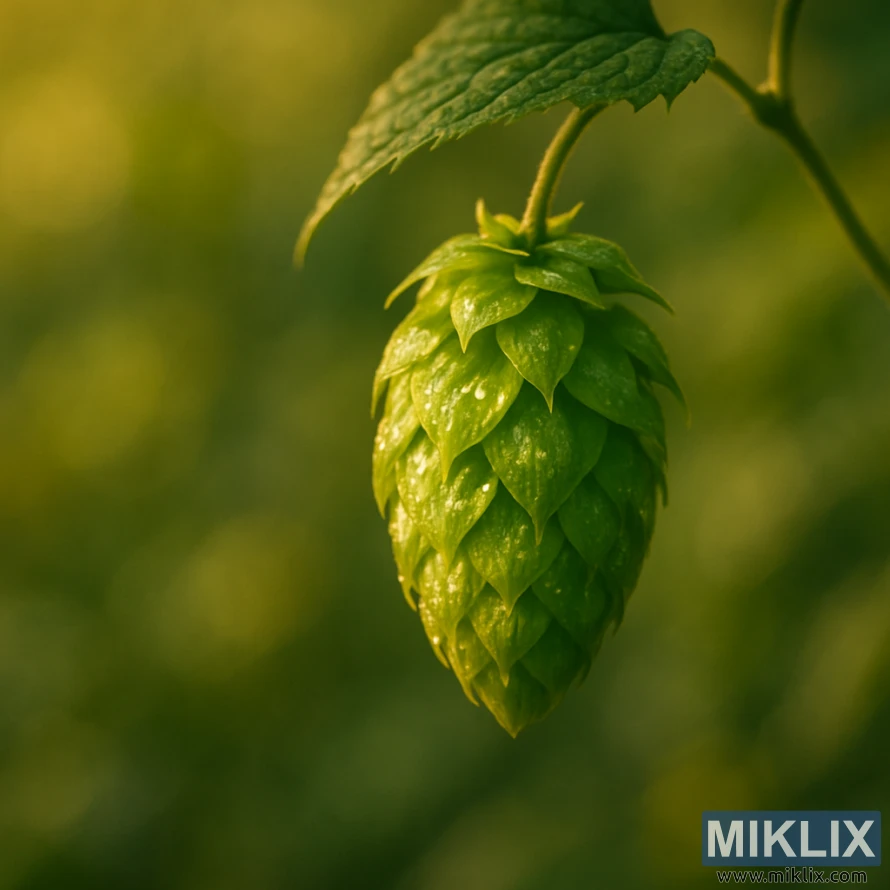
Brewing Values and Practical Usage
Dana brewing values position this hop as a dual-purpose variety. Alpha acids range from about 7.2% to 13% with an average near 10%. Beta acids sit roughly between 2.7% and 6% with a 4% plus average. Total oils normally run 0.9–1.6 mL/100g. These metrics make Dana suitable for a wide span of Dana usage in modern brewing.
Use Dana for early boil additions when you want moderate-to-strong bitterness. Cohumulone commonly falls between 22% and 31%, so expect a clear, balanced bittering character. Brewers often choose Dana for bittering aroma Dana profiles that remain harmonious rather than harsh.
For hop additions later in the process, Dana shows its floral and citrus side. Late kettle, whirlpool, and dry-hop treatments bring out bright citrus top notes and gentle floral lift. Adjust rates by measured alpha acid each harvest year to account for variability.
Practical guidance for dosage follows typical dual-purpose practice. Start with bittering rates adjusted to the beer's target IBU, then add 10–30% of total hop weight as late additions to secure aroma. Many professionals note that Dana usage yields a smooth bitterness and an aromatic finish that complements pale ales and Belgian-style beers.
- Alpha range to check: 7–13% (measure current lot).
- Target bittering: use early additions for medium to firm IBUs.
- Aroma work: late additions, whirlpool, and dry-hop for citrus/floral lift.
- Adjust rates seasonally to match lab values and desired balance.
Beer Styles That Showcase Dana Hops
Dana hops are perfect for beers that are hop-forward yet balanced. In pale ales, they add light citrus and soft floral notes. These enhance the malt backbone without overwhelming it.
American pale ales benefit from Dana's unique character. The hop's aroma can be emphasized while keeping bitterness in check. Single-hop pale ale trials show Dana's clean citrus and gentle herbal finish.
India Pale Ales also benefit from Dana. It adds bright resinous and fruity layers to both West Coast and New England IPAs. Use Dana for late additions and dry hopping to enhance aroma without harsh bitterness.
English-leaning beers, like Extra Special Bitter, are a great fit for ESB Dana. This variety brings balanced bitterness and subtle floral notes to a full, toasty malt profile.
- American pale ale: spotlight Dana in pale ale for aromatic clarity and drinkability.
- IPA: emphasize Dana in IPA for late-hop aroma and smooth citrus lift.
- ESB: choose ESB Dana to blend floral notes with traditional English malt.
These Dana beer styles showcase the hop's versatility in both aroma-driven and balanced bittering roles. Brewers looking for a hop that complements rather than dominates will find Dana suitable for a variety of pale and bitter styles.
Dosage Guidelines and Typical Rates
Begin by examining the alpha acids and oil report for your specific lot of Dana. Dana's alpha ranges typically span from 7% to 13%. This range is crucial for calculating bittering additions accurately, ensuring precise IBU outcomes.
For bittering, apply standard IBU formulas and adjust according to the current alpha measurement. Dana's initial kettle additions should mirror those of other high-alpha hops. Adjust grams per liter to align with your desired IBU.
In late kettle or whirlpool additions, Dana acts as a citrus and floral aroma hop. Moderate additions enhance hop character without overpowering malt or yeast. Many brewers opt for small, frequent additions to build complexity.
Dry-hopping is where Dana truly excels for aroma. Expect aromatic dosages similar to those in Pale Ales and IPAs. Recommendations for dry-hop intensity range from light to heavy, typically 10–40 g/L, depending on the desired intensity and beer style.
- Calculate bittering by alpha percent, not by a fixed recipe number.
- Adjust Dana hop rates for each crop year and lab analysis.
- Use 10–40 g/L as a working range for dry-hop intensity in hoppy ales.
For those wondering about Dana hop quantities, convert grams per liter to ounces per gallon for ease. Small trial batches are invaluable for fine-tuning Dana dosage before scaling up.
It's essential to log Dana addition rates and sensory feedback for each lot. Tracking these adjustments ensures consistent beer quality across different seasons.
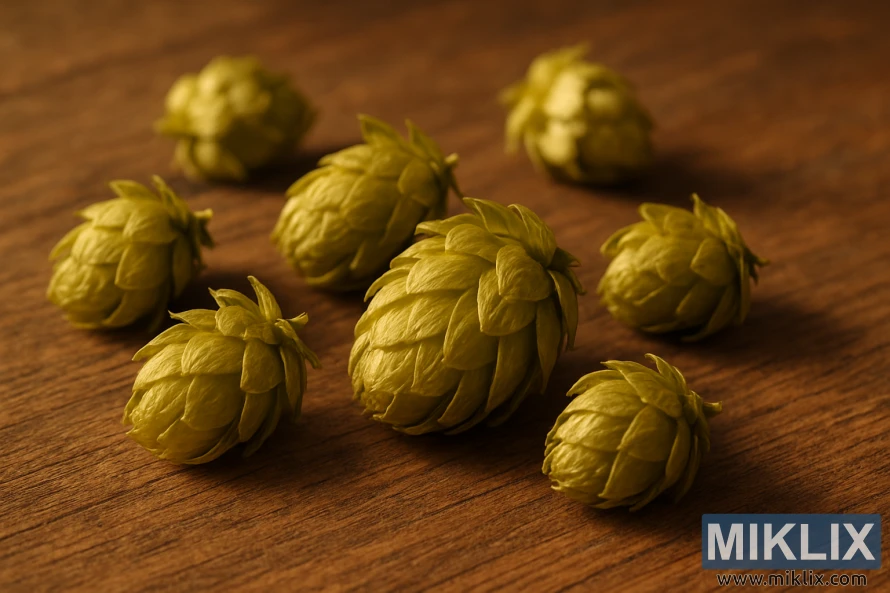
Hop Pairings and Complementary Varieties
Dana hop pairings are effective when you match its citrus, floral, and pine notes with complementary hops. For bold American IPAs, pair Dana with Citra to enhance citrus and tropical flavors. Cascade is a classic choice to emphasize grapefruit and resin in pale ales.
For a more balanced profile, Saaz offers noble, spicy, and herbal counterpoints that temper Dana’s punch. Willamette and Fuggle serve as gentle complements for English-style rounding. These varieties add herbal, tea-like depth without overwhelming Dana’s aroma.
- Citra — bright citrus and tropical lift; ideal for modern IPAs.
- Cascade — classic grapefruit and resin; great in pale ales.
- Saaz — noble spice and earth; brings restraint and elegance.
- Willamette and Fuggle — English herbal/earthy notes; smooth finish.
Brewers often use Dana complements in layered additions. A small whirlpool of Saaz or Willamette can ground late additions of Dana and Citra. Dry hopping with a majority of Dana and a minority of Cascade yields a forward citrus aroma with a stable bitter backbone.
When designing recipes, test small batches. The best hops with Dana depend on target style and malt bill. For bright, modern beers, favor American varieties. For traditional ales, blend Dana with English or European hops to achieve a nuanced balance.
Substitutions When Dana Is Unavailable
When Dana is out of stock, brewers seek alternatives that match its alpha and myrcene profile. Classic UK varieties like Fuggle and Willamette are practical substitutes. They offer a gentler bitterness and add earthy, herbal notes, keeping recipes balanced.
For a brighter citrus and floral lift, American varieties such as Cascade or Citra are ideal. Replacing Dana with Cascade or Citra shifts the aroma towards citrus and grapefruit. This change is perfect for pale ales and IPAs that require a forward fruit character.
When selecting hops similar to Dana, consider their oil composition. Look for mid-alpha hops with higher myrcene and moderate humulene. These traits help preserve Dana's resinous and citrusy impressions, even without the exact cultivar.
- Fuggle — earthier, herbal profile; good for malty ales and amber beers.
- Willamette — floral and spicy; softens bitterness and adds vintage aroma.
- Cascade — bright citrus; use when you want a zesty hop note.
- Citra — intense tropical and citrus; best for aroma-forward beers.
Choose your substitute based on your priorities. For maintaining bitterness balance, Fuggle or Willamette are good choices. For highlighting citrus or tropical aroma, opt for Cascade or Citra. Adjust the rates slightly to account for alpha differences and desired aroma intensity.
Be aware that Cryo or lupulin concentrates for Dana are scarce. You may not find lupulin powder for Dana, so plan for whole-cone, pellets, or standard extract forms when sourcing alternatives.
Use pairing lists from beer analytics and your tasting notes to refine your choices. Trial small batches when possible. This approach helps confirm whether a chosen hop preserves the original beer’s balance and character.
Agronomic Traits and Grower Considerations
Dana agronomy combines practical vigor with traits that appeal to commercial farms. Developed at the Žalec hop institute, Dana shows adaptation to Central European climates. This breeding background explains its resilience and predictable growth patterns.
Growing Dana hops demands normal trellis and irrigation practices used for other aroma varieties. Plants establish quickly and tolerate common foliar stresses when managed with standard nutrient programs. Seasonal weather still affects cone chemistry, so monitoring during bloom and ripening is important.
Growers report steady Dana yields under good management. Crop size can vary by region and by the harvest year, so plan contracts with buyers that account for year-to-year changes. Harvest timing influences alpha acids and oil profile, so coordinate field tests with processors.
- Site selection: full sun, well-drained soils work best for consistent Dana yields.
- Pest and disease: mildew and aphids require routine scouting; Dana has acceptable tolerance but not immunity.
- Supply planning: multiple suppliers offer Dana, yet availability shifts by harvest year and demand.
Field trials from the Žalec hop institute emphasize local male genetics used in Dana’s development. This local breeding translates to traits suited for Slovenia and similar climates. It helps growers in comparable zones in the United States evaluate performance.
Tracking seasonal variability in alpha content and oil levels helps maintain quality for brewers. Regular sampling, clear communication with buyers, and flexible storage plans improve returns when growing Dana hops for commercial markets.
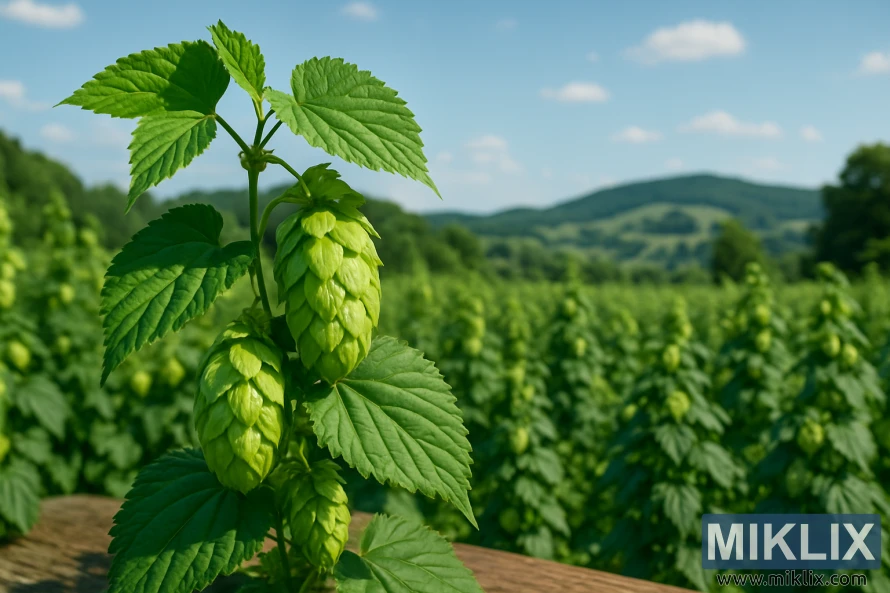
Product Forms and Availability
Dana hops availability changes with the seller and harvest year. U.S. hop shops and national suppliers list Dana, showing stock levels that fluctuate seasonally. You can find Dana hops at larger retailers or online platforms like Amazon. Prices and availability depend on the supplier's current stock and the latest crop.
Dana hops come in two main forms: Dana pellet and Dana whole cone. Brewers often prefer pellets for their convenience in storage and dosing. Homebrewers and small breweries, on the other hand, might choose whole-cone for its traditional appeal or specific handling needs.
Currently, there are no commercial Dana lupulin concentrates available from major processors. Yakima Chief Hops, Barth-Haas, and Hopsteiner do not offer a Cryo, LupuLN2, or Lupomax Dana product. This scarcity limits options for brewers seeking highly concentrated whirlpool or dry-hop additions using lupulin-only material.
Recipe databases and hop catalogs frequently feature Dana in aroma-focused roles. Over 170 recipes mention the variety, indicating a steady interest in its unique profile. This interest explains why Dana pellet and Dana whole cone remain the primary choices for brewers.
- Orderability: Several hop shops list Dana as ready to order during peak months.
- Form choice: Pellet form often wins for compact storage and consistent dosing.
- Concentrates: Dana lupulin is not currently available from major lupulin producers.
When planning to buy Dana hops, always check the harvest year and seller notes. Freshness and packing date are crucial, as whole-cone and pellet forms behave differently in brewing. This is more significant without a lupulin option, as they impact extraction in both whirlpool and dry-hop phases.
Analytics and Historical Popularity
Data from brewing analytics platforms reveals Dana's growing popularity among craft brewers. It's favored in Pale Ale and IPA styles. Beermaverick-style production summaries and hop trade widgets show Dana alongside well-known varieties. Craft brewers seek its citrus and floral notes.
Beer-Analytics datasets list Dana in 172 recorded formulations. These datasets track Dana's usage by year, style, and region. The counts show Dana's common use in late-addition hopping and dry-hop applications for hop-forward ales.
Flavor profiling tools rate Dana's flavor intensity at 7 on a 10-point scale. Production and sensory entries inform brewers on dosage and timing. This rating supports Dana's dual-purpose role in both bittering and aroma work.
Observed recipe patterns show Dana often paired with classic American and New World hops. Recipe archives highlight common pairings, typical percentages, and preferred boil or whirlpool stages.
- 172 recipes recorded with Dana
- High concentration in Pale Ale and IPA formulations
- Flavor intensity rating: 7 (industry dataset)
Regional differences impact Dana's popularity, with stronger adoption in European and North American craft communities. Crop variation and harvest yields affect availability and reported usage statistics by distributors and breweries.
Analytics platforms offer actionable insights: usage by recipe stage, average grams per liter, and seasonal trends. Brewers use these figures to align recipe goals with ingredient sourcing. They also track Dana's usage shifts with market demand and crop reports.
Recipe Ideas and Example Formulations
Begin by reviewing the lot alpha and oil reports from your supplier. Dana harvests can vary, so adjust IBUs and late additions based on the measured alpha. This ensures a precise Dana pale ale formulation or Dana IPA recipe.
Use these quick outlines as a starting point. For single-hop showcases, keep grain bills simple. A classic pale ale uses a firm pale malt base with a touch of crystal for body. An IPA, on the other hand, requires a higher malt content and slightly warmer mash temperature. This supports the higher hop loads without thinning the beer.
- Quick Pale Ale approach: 88–92% pale malt, 6–10% light crystal, 2–4% Munich. Early bittering with Cascade or split with Dana to hit target IBUs, then late/whirlpool Dana plus dry-hop for lemon, floral and pine lift.
- IPA approach: heavier base malts, 10–14% specialty, crisp mash profile. Calculate bittering using actual alpha to meet your IBU goal, reserve most Dana for late additions and dry-hop. Blend Dana with Citra for bright citrus top notes.
- ESB and session ales: modest Dana additions focused on balancing bitterness with subtle floral aroma. Lower dry-hop rates keep the profile restrained and drinkable.
Follow measured hops schedules for balance. Place 60–75% of bittering hops early, 20–30% at whirlpool, and 30–60 g/L-equivalent in dry-hop. This depends on batch size and alpha. Use Dana recipes that list exact grams per gallon or grams per kilogram for precise scaling.
When blending hops, consider aroma synergy. Cascade adds grapefruit brightness, Citra brings strong citrus intensity, and Saaz can tame sharpness with herbal notes. Many formulators pair Dana with these varieties to enhance the floral-citrus character without masking it.
- Example Dana pale ale formulation (5 gal): base malt 10 lb, light crystal 1 lb, Cascade 0.5 oz 60 min, Dana 0.5 oz 15 min, Dana 1.5 oz whirlpool, Dana 2 oz dry-hop 3–5 days. Adjust for alpha.
- Example Dana IPA recipe (5 gal): base malt 12 lb, specialty 1.5 lb, bittering hops measured for IBUs at boil using Dana alpha, Citra 1 oz late, Dana 2 oz whirlpool, Dana 4 oz + Citra 2 oz dry-hop. Tweak to desired citrus punch.
Taste and tweak small test batches. Keep records of alpha, oil notes, and perceived bitterness for each lot. This practice improves consistency across Dana recipes. It helps dial in the ideal Dana pale ale formulation or Dana IPA recipe for your brew house.
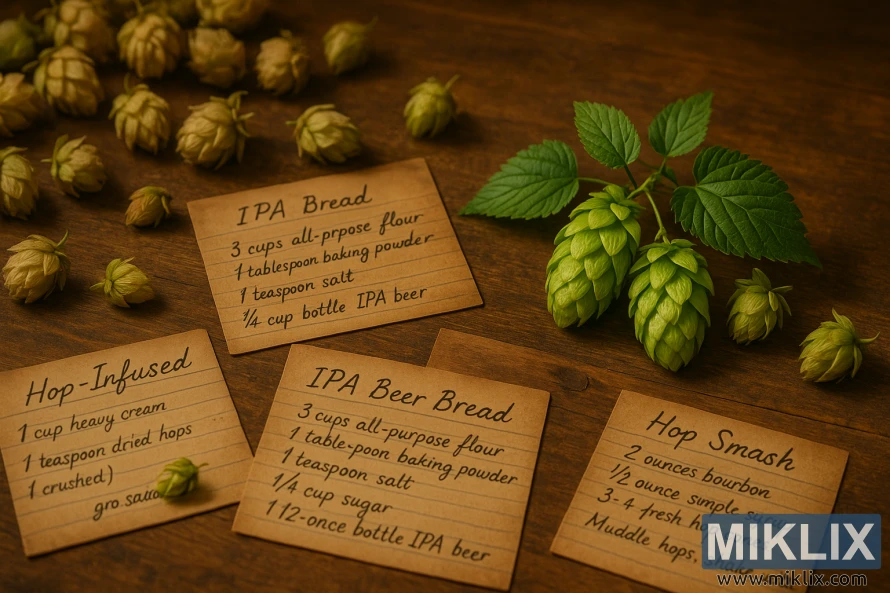
Tasting and Evaluation Techniques for Dana-Hopped Beers
Conduct small-scale trials to isolate Dana’s unique characteristics. Perform dry-hop and whirlpool trials in identical wort to uncover floral, lemon, and pine notes. Ensure consistent temperatures and contact times for accurate comparisons.
Score aroma intensity and bitterness separately. Dedicate a sheet for aroma evaluation, focusing on citrus, floral, and resinous tones. Assess bitterness on a scale that reflects medium to robust perception. Record perceived smoothness alongside measured IBUs to understand cohumulone effects.
Employ hop sensory testing methods like triangle tests to detect subtle differences. Present three samples, two identical and one different, to trained tasters. Ask them to identify citrus, floral, and pine notes and mark their confidence levels.
Compare flavor intensity numbers with oil composition data. A flavor intensity of seven indicates a bold profile. Focus hop sensory testing on the dominant oils that drive these notes. Note any shifts between bench and brewed samples.
- Run paired bittering trials to connect measured IBUs with perceived harshness.
- Document harvest-to-harvest variation by testing multiple lots from the same supplier.
- Keep tasting sheets that track aroma descriptors, intensity scores, and brewing parameters.
When tasting Dana hops, maintain sample freshness and avoid cross-contamination. Smell whole cones, hop pellets, and beer headspace to triangulate aroma sources. Take notes immediately to preserve sensory accuracy.
To evaluate Dana aroma in finished beer, use neutral glassware and standard pouring technique. Let the beer rest briefly, then record first impressions, mid-palate notes, and aftertaste. Compare these notes to the bench trials to map extraction efficiency.
Regular hop sensory testing across batches helps calibrate expectations and dosing. Track which treatments—dry-hop weight, whirlpool schedule, or contact time—produce the clearest lemon, floral, or pine signatures in your target style.
Legal, Labeling, and Sourcing Notes for U.S. Brewers
U.S. brewers sourcing Dana should verify supplier documentation before making a purchase. Dana is available from multiple vendors and can be found on platforms like Amazon. This means availability, harvest year, and pricing can fluctuate between lots. It's crucial to confirm lot numbers and certificates of analysis to ensure alpha, beta, and oil values align with your recipe requirements.
Importing Dana hops requires adherence to USDA and APHIS phytosanitary regulations. Brewers must provide paperwork proving the lot meets U.S. entry standards. Collaborating with customs brokers and exporters is essential to secure necessary permits and inspection receipts, preventing delays at the port.
Keeping detailed Dana supplier notes for each batch is vital for traceability. Record vendor name, harvest year, COA, and any storage or transport conditions. These records are crucial for quality control and resolving any off-flavor or stability issues post-packaging.
Compliance with federal labeling rules is mandatory when advertising specific hop varieties. TTB guidelines demand truthful labeling, including accurate statements about hop varieties and origin. If your beer advertises Slovenian origin for Dana, having origin documentation readily available is essential to support marketing claims.
Expect Dana to be available in pellet or whole-cone formats, not lupulin concentrates. Major processors like Yakima Chief Hops, Barth-Haas, and Hopsteiner do not commonly list Dana lupulin concentrates. Plan your procurement and inventory management with the understanding that pellets and whole-cones are the typical formats for Dana sourcing in the U.S.
Use a short checklist at purchase to streamline compliance:
- Verify COA and lot number against your recipe needs.
- Confirm phytosanitary clearance when you import Dana hops.
- Document Dana supplier notes for traceability and audits.
- Align hop labeling with TTB rules and origin claims.
Maintaining a clear audit trail is essential to reduce risk during inspections. Ensure COAs, invoices, and shipping manifests are readily accessible. This approach helps safeguard your brand against any questions about the provenance or chemical makeup of Dana hops used in production.
Conclusion
Dana hops are versatile, fitting well in both bittering and late-addition roles. They are bred in Žalec from Hallertauer Magnum and a native wild male. This combination results in moderate-to-high alpha acids, typically around 7–13%. The myrcene-forward oil mix offers citrus, floral, and pine notes, making Dana a popular choice for brewers seeking balance and aromatic clarity.
In practical brewing, Dana shines in Pale Ales, IPAs, and ESBs. It's ideal for both straightforward bittering and complex aroma layers. Pair it with Cascade, Citra, Saaz, or English varieties to achieve the desired character. Always check supplier COAs and harvest-year variability to fine-tune IBUs and hop additions.
Dana's availability from growers and processors makes it accessible to U.S. brewers. While there are no major lupulin or cryoconcentrate products widely available, Dana can be sourced in pellet and whole-cone formats. In summary, Dana offers reliable bitterness, clear citrus-floral aromatics, and practical sourcing for recipe development.
Further Reading
If you enjoyed this post, you may also like these suggestions:
